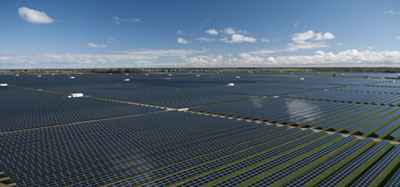Thanks to the enormous utility-scale solar plants that now dot the west, solar should be supplying 1% of US electricity by the end of this year, says Pete Danko at Breaking Energy.
That percentage is, of course, small, but it represents gigantic growth – over 100% this year as compared to the same period in 2013, he says. And if you look back to 2008, there was basically zero solar in this country.
In the first nine months of 2014, utility-scale solar produced 0.4% of US electricity – 12,303 gigawatt-hours supplying 1,513,703 homes – compared to 6,048 GWh in the same period of 2013, according to the US Energy Information Administration.
Add in rooftop, commercial PV and more utility-scale plants coming online and we get to 1% this year.
Topaz Comes Online
In late October, the largest solar plant in the world began full commercial operations, the 550 megawatt (MW) Topaz Solar PV project.

Owned by Buffet’s utility, MidAmerican Solar, 9 million solar panels cover 9.5 square miles in California’s San Luis Obispo county. Construction began in 2012 and finished before the early 2015 delivery date. Built by First Solar on "disturbed farmland," the project received no government subsidies.
First Solar is also close to completing another 550 MW project, Desert Sunlight (owned by NextEra, GE, Sumitomo) and SunPower is more than half finished building Solar Star for another 579 MW (owned by MidAmerican).
Yesterday, Abengoa’s 280 MW Mojave Solar farm near Los Angeles starting sending electricity to 90,000 homes.
More big PV projects coming:
- McCoy -750 MW in Blythe, CA, owned by NextEra
- Tranquillity Solar – 400 MW in Fresno County, CA, will be built by Recurrent Energy in eight phases – also on disturbed farmland.
- Redwood Solar Farm – 135 MW in Kern County, CA, built by 8minutenergy Renewables.
"If it hadn’t been for these projects, I can’t tell you how many people would have lost their homes or cars. It’s been a godsend," Kevin Cole of the International Brotherhood of Electrical Workers told the Fresno Bee.
At least four iconic projects have been shelved or rejected in California because of potential wildlife impacts or lack of financing: Rio Mesa, Hidden Hills, Palen, Silurian Valley and Rice Solar.
Problems Ahead
Going forward, several issues are coalescing to make it much harder for brand new projects:
- utilities are getting close to meeting California’s Renewable Portfolio standard, which requires 33% renewables by 2020. Unless that goal is raised, utilities are showing less interest in signing long-term power contracts
- having signed power contracts in hand is critical for getting projects financed
- and the federal tax credit goes from 30% of a project’s construction cost to 10% at the end of 2016. Projects have to be finished to receive the subsidy, which is less and less likely as we get closer to that date.
- projects are costing more than expected because of stringing requirements to mitigate their environmental impact.
"The government and everyone keep saying we need to replace oil, we need renewable energy. And then they don’t extend this 30% tax credit, and they give a deadline that makes it impossible to build new plants at the present time," Mark Jabin, an owner of the land where Rice would be built, told The Desert Sun.
The solar industry is lobbying Congress to extend the 30% investment tax credit, or at the very least, change the law so that projects that begin construction by the end of 2016 can qualify (as they did for the wind PTC).
Their best hope may be in California, where AB327 – signed into law last year – makes the 33% renewables requirement a floor rather than a ceiling, giving the California Energy Commission the authority to mandate more use of renewables by utilities.
"There’s no question that uncertainty in the marketplace is creating a lot of angst for investors and project developers," Ken Johnson of the Solar Energy Industries Association, told The Desert Sun.
While we’re not crazy about more huge power plants consuming open space and habitat, it’s a shame because most of the big plants are performing better than expected and thanks to the big drop in price, new ones can be built now much more cheaply. And they create thousands of jobs.
Read the full article:
